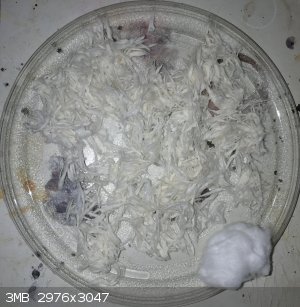Σldritch
Hazard to Others
  
Posts: 309
Registered: 22-3-2016
Member Is Offline
Mood: No Mood
|
|
Synthesis of oxidized cellulose paper
Does anyone know a way to make oxidized cellulose paper? I tried heating 100% cotton paper in a solution of 1:1 Sodium Persulfate to Sodium Carbonate
but it did not seem to work.
H2O + Na2S2O8 + 2 Na2CO3 ---> [O] + 2 Na2SO4 + 2
NaHCO3
Note that i did not use Sodium Bicarbonate because it will ruin the papers structure when Carbon Dioxide evolves.
Here is the wikipedia page: https://en.wikipedia.org/wiki/Oxidized_cellulose
If possible i would like to use an oxidizer that leaves a lot of carbonyl groups with as strong as possible cellulose. It seems the paper i used did
not want to soak up the solution very well, is there some way to help it soak up? Maybe boiling it in water first?
|
|
|
aga
Forum Drunkard
    
Posts: 7030
Registered: 25-3-2014
Member Is Offline
|
|
I think those solutions would be somewhat basic, which reminds me of an old process to make oxalic acid with wood shavings (also cellulose) and NaOH
with heating.
Perhaps something like that happened instead of what you expected.
|
|
|
Σldritch
Hazard to Others
  
Posts: 309
Registered: 22-3-2016
Member Is Offline
Mood: No Mood
|
|
I probably did hydrolyse it a bit, it had a somewhat slimy texture. However reading more on oxidized cellulose, maybe that was my product because
oxidized cellulose is supposed to be soluble. Probably due to loss of hydrogen bonding between chains. If it is soluble, how will i get rid of the
salts? Maybe hydrogen peroxide is better.
I think i will try with thinner paper, is regular printer paper lignin free?
[Edited on 13-2-2018 by Σldritch]
|
|
|
Bert
Super Administrator
        
Posts: 2821
Registered: 12-3-2004
Member Is Offline
Mood: " I think we are all going to die. I think that love is an illusion. We are flawed, my darling".
|
|
See liquid CO2 reference in the compressed wood thread?
Claims it oxidizes lignin and extracts the products, what's it going to do to the cellulose on longer contact? Also, could liquid CO2 be "doped" with
one of your suggested oxidants?
What's the intended use for the material? Wikipedia was kind of uninformative.
| Quote: |
I think i will try with thinner paper, is regular printer paper lignin free?
|
Plain, white (unscented, no lotion or other additives) facial tissue or toilet paper works well for a number of other cellulose modifications
(estrification, anyone?) About as close to pure cellulose as you can easily get OTC.
Quite asside from remaining lignin, most "writing" or "copier" paper has plenty of mineral and/or resin fillers along with other adjunts and
modifiers, even ph buffers to prevent embrittlement from retained process chemicals in the fiber on aging.
[Edited on 13-2-2018 by Bert]
|
|
|
Σldritch
Hazard to Others
  
Posts: 309
Registered: 22-3-2016
Member Is Offline
Mood: No Mood
|
|
Maybe printer paper is not such a good idea, ill visit an art store and ask, anyway i made some oxidzed cellulose from cotton as a test.
Materials:
Cotton 10g
Hydrogen peroxide 100ml (12.5%)
Distilled Water 210ml + some for washing
Acetone
A pinch of ferrous sulfate
Procedure:
The cotton was loosly placed in a jar and 200ml of distilled water and 100ml Hydrogen Peroxide solution were added and stirred in with a glass rod. A
pinch or two of technical grade Ferrous Sulfate were dissolved in 10ml of water and added to the cotton with stirring. This was left for about 8 hours
at room temprature with occasional agitation with a glass rod to remove oxygen bubbles and submerge the cotton. After 8 hours the oxygen generation
rate should have slowed down considerably and is decanted. The product is washed twice in cold tap water, twice in distilled water and once in
acetone, pinced into small pieces and left to dry.
Observations:
After the reaction had progressed for some time some increased stability of bubbles on the surface was observed implying dissolved polymer. The pH of
the solution was also tested at this time showing a pH of ~5.5 . The product is slightly yellow, some sources claim oxidized cellulose is pale yellow
but the color could come from iron.

[Edited on 13-2-2018 by Σldritch]
|
|
|
Bert
Super Administrator
        
Posts: 2821
Registered: 12-3-2004
Member Is Offline
Mood: " I think we are all going to die. I think that love is an illusion. We are flawed, my darling".
|
|
If you NEED it to be in normal, flat paper form, the thinnest tracing paper they can give you at the art store is probably your best bet for cellulose
without extra goodies. This is what we use when making magician's flash paper-
The described washing step sounds a bit light to me, but I'm used to trying to remove acid from inside the (tubular!) cellulose fibers to prevent self
catalyzing breakdown in storage, which takes rather more steps.
But what's it FOR? Just something you were interested in?
|
|
|
Σldritch
Hazard to Others
  
Posts: 309
Registered: 22-3-2016
Member Is Offline
Mood: No Mood
|
|
I want to strenghthen cellulose by crosslinking it with urea, which is why i want it in paper form.
[Edited on 13-2-2018 by Σldritch]
|
|
|
aga
Forum Drunkard
    
Posts: 7030
Registered: 25-3-2014
Member Is Offline
|
|
If you just want cellulose, use "Schweitzer's Reagent" or a zinc chloride solution.
Clearly the feedstock will determine how much work will be required to get 'clean' cellulose.
The zinc chloride route takes days, but still works.
|
|
|